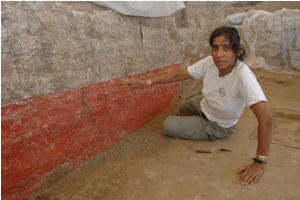
In raw numbers, social distance between the photographer and the subject of the photograph decreased over time, with over three times as many shots taken of excavations at a 'medium' distance by Quinlan in 2006 as there were in 1963 by Todd (Figure 3). The composition, framing and quantity of photographs could be partly attributed to the different technologies relating to analog and digital photography and of the physical conditions on site. Many of the BACH photographs in 2000 were taken within the confines of a tent structure over the excavation, which may explain the paucity of 'far' distance photographs. The BACH team discussed the technological advantages of digital photography, noting greater creativity, near-instant access to the images, lower cost and a 240% increase in the amount of photographs as they moved from analog to digital (Tringham and Ashley with Quinlan 2012). This is also reflected in the 2014 re-hash of this study, wherein a similar increase resulted from the adoption of 3D recording strategies such as structure from motion imaging (Quinlan and Morgan 2014). While there was a rapid increase in the number of photographs, these initial digital photographs were considered to be worse in quality than analog photos, with quality measured as usefulness for archaeological explanation or illustrations in reports (Shahina Farid 2014, pers. comm.). An increase in quality occurred gradually between 2000 and 2006, after digital photography became normalised. A parallel decrease in quality came after the widespread adoption of structure from motion imaging (Jason Quinlan 2014, pers. comm.).

This quantitative device of measuring framing distance encouraged a closer qualitative look at the photographs as well, which revealed a varied treatment of bodies by the photographers. The photos Todd took of the Turkish workers that Mellaart employed to excavate never came closer than a 'medium' distance, and more often they were depicted far away. They were also rarely segmented in the frame, but captured as whole bodies working within the photograph. This separation between the archaeologists framing the photos and workers was also noted in the Dura-Europos photographic archive (Baird 2011). Measuring 'behaviour' by noting eye contact with the camera was less conclusive – there were similar amounts of eye contact and no eye contact in Todd and Quinlan's photos, for example. Yet quantifying eye contact also encouraged further consideration of the relationship between the photographer and the subject of the photograph.


In Figure 4, the photographer is looking down on the team of excavators from the edge of the excavation trench, his shadow overlaying one of the workers. The excavators are posed with a plastered bull skull, mounted in one of the walls. Two of the men are pointing toward the skull, and two are regarding the photographer, eyes shaded by their hats. In Figure 5, the photograph is again taken from above, with excavators depicted as whole figures, working in tandem while being supervised by the figure on the right. There is a marked social distance between the photographer and his subjects; the workers serve to illustrate the production of the archaeological process and there is no attempt to portray them as individuals.

Photographs taken by the BACH Team in 2000 are framed at a close social distance, the photographer working alongside the excavators. The archaeological process is apparent, with tools and clutter remaining in the photo, in contrast to calls for cleanliness in publications about archaeological photography (Figure 6). Photos of important artefacts are repeated several times, with and without photo scales, and from different angles, showing many perspectives of the same subject. Excavators are seen as deeply involved in the surrounding archaeology, yet are almost all segmented bodies, portrayed as either headless or looking away from the camera. The gaze of the archaeologist depicted is not engaged with the camera, but is looking at the 'real' subject of the photograph, the archaeological object, and encourages the viewer to follow his or her line of sight (Figure 7).

Jason Quinlan's 2006 photography is often taken at an extremely close social distance, showing the faces of the excavators as they work. In Figure 8, Shahina Farid is visibly engaged in conversation with the photographer, even as her photograph is taken. Authorship of the excavation is explicit, with the tools of the excavators in their hands, their faces visible, bits of red wall taken off during excavation (Figure 9) not hidden or swept away, but still in the photograph as evidence of the inevitable destruction of archaeology. The subjects of the photographs are aware of the photography, and are engaged with the photographer, forming an easy dialogue.


Internet Archaeology is an open access journal based in the Department of Archaeology, University of York. Except where otherwise noted, content from this work may be used under the terms of the Creative Commons Attribution 3.0 (CC BY) Unported licence, which permits unrestricted use, distribution, and reproduction in any medium, provided that attribution to the author(s), the title of the work, the Internet Archaeology journal and the relevant URL/DOI are given.
Terms and Conditions | Legal Statements | Privacy Policy | Cookies Policy | Citing Internet Archaeology
Internet Archaeology content is preserved for the long term with the Archaeology Data Service. Help sustain and support open access publication by donating to our Open Access Archaeology Fund.